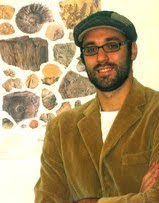From the Paleolithic fossil pendant to Hannah Ingalls's wooly trilobite, geologic objects are often used as items of personal adornment. For this reason, it should sound trivial to speak - again! - of geologic fashion accessories, but this time I will tell of fecal fashion: coprolites!
Coprolites are fossil dung. They are prized objects for paleontologists as they provide direct evidence of the diet of extinct organisms and they can shed light on paleoparasitological issues.
In the late 19th century, the British geologist John Stevens Henslow understood the potential of coprolites as a source of phosphate and soon coprolites were mined on an industrial scale for their application as fertilizers.
The coprolite mining area was located in the Cambridgeshire (Eastern Britain), while the refining process was carried out by the Fison Company in Ipswich. For this reason, nowadays you find "Coprolite street" in Ipswich!
In the late 19th century, the British geologist John Stevens Henslow understood the potential of coprolites as a source of phosphate and soon coprolites were mined on an industrial scale for their application as fertilizers.
The coprolite mining area was located in the Cambridgeshire (Eastern Britain), while the refining process was carried out by the Fison Company in Ipswich. For this reason, nowadays you find "Coprolite street" in Ipswich!
Visualizzazione ingrandita della mappa
Click on the picture to walk around Coprolite street!
The true nature of coprolites was discovered in the 19th century by William Buckland, one of the most influential figures in the history of paleontology. Known for his eccentric habits, Buckland possessed a table made entirely of his coprolite specimens. If you think that this was his weirdest behavior, you are wrong. Indeed he had the reputation for eating everything that had a pulse, including bluebottle, panther, crocodile and the preserved heart of the French King Louis XIV.
 | ||||||
|
 |
| Artya's Coprolite Watch, made of actual fossil dung. |
Famed as the first scene with deep time, Duria Antiquior shows the first stage of the production of coprolites, that is... well, see the watercolor for more details.
 |
| "Duria Antiquior, a more ancient Dorset" by Henry de la Beche |
In conclusion, coprolites are waste products only apparently. Indeed, fossil dung is precious either for scientists or for artists. With the words of the 19th century author Francis Buckland:
| Geopoetry: "Approach, approach, ingenuous youth, And learn this fundamental truth:The noble science of Geology is founded firmly in Coprology." Click on the image to read the whole book! |






Lovely and informative posting. Thank you. I cited it on a discussion group, having found in by googling 'art of coprolites' ...
ReplyDeletehttp://www.objectivistliving.com/forums/index.php?showtopic=12846&p=178283